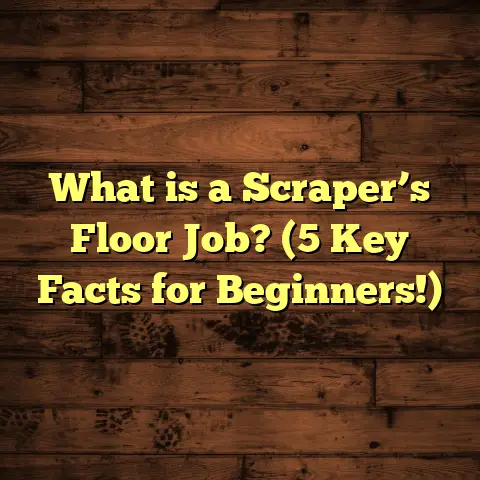What is Texas Granite Flooring Cost? (5 Factors Influencing Price)
Sometimes, I find myself thinking about how granite flooring pops up in movies and TV shows—those sleek, shiny floors underfoot in fancy mansions or high-end offices. Have you noticed that? It’s like granite flooring has this quiet way of making a space feel both timeless and luxurious. I remember watching an episode of “Dallas” back in the day, where the Ewing mansion had those gleaming stone floors that seemed to say wealth without shouting it out loud. That image stuck with me. If you’ve ever wondered about the cost of granite flooring in Texas, you’re not alone. I’ve spent quite some time dealing with granite flooring projects here in the Lone Star State and thought I’d share everything I’ve learned about what influences the price and what you should expect.
What is Texas Granite Flooring Cost?
Let’s start simple: what exactly is granite flooring, and why does its cost vary, especially in Texas?
Granite flooring is made from granite, a natural stone formed from cooled magma deep within the earth’s crust. This igneous rock is prized for its durability, hardness, and beautiful grain patterns. It’s composed mainly of quartz, feldspar, and mica, which give it that unique speckled appearance. Granite slabs are cut, polished, and finished to be used as floor tiles or slabs. Because it’s a natural material, no two pieces are exactly the same, lending a unique look to every installation.
The cost of granite flooring in Texas refers to the total price homeowners or contractors pay to install granite on floors. This price includes multiple components: the raw granite material cost, labor costs for installation, preparation work like removing old flooring or leveling subfloors, transportation fees, sealing and finishing expenses, and any additional charges such as custom cutting or waste management.
In Texas, granite flooring prices can vary widely—from around $7 per square foot to over $30 per square foot—depending on several factors. You might ask yourself: Why such a broad range? The answer lies in the variables that affect both the granite itself and the installation process.
Manufacturing Process and Technical Specs
Understanding how granite gets from deep underground to your floor helps explain its cost and quality differences.
Granite starts as massive stone blocks quarried from large deposits worldwide—including Texas itself. These blocks are huge—sometimes weighing several tons—and require heavy machinery to extract safely.
Once quarried, these stone blocks are transported to cutting facilities. Here’s where things get technical: the massive blocks are sliced into slabs using diamond wire saws or gang saws. Diamond wire saws consist of a looped wire embedded with diamond segments that cut through stone with precision. Gang saws use multiple blades that slice at once. The choice of cutting method affects yield, slab thickness, and cost.
Slabs typically come in thicknesses of 2 cm (about 3/4 inch) or 3 cm (around 1 1/4 inch). Thicker slabs are heavier and more durable but also cost more due to greater material use.
After cutting, slabs undergo polishing machines that use abrasive pads to create a smooth and glossy surface. Polishing enhances the stone’s color vibrancy and makes it easier to clean and maintain.
Granite’s hardness rates between 6-7 on the Mohs scale—meaning it’s very resistant to scratches but not impervious. This hardness contributes to its long lifespan as flooring material.
Sealing granite is necessary because its natural pores can absorb liquids, leading to stains over time.
5 Factors Influencing Texas Granite Flooring Cost
Now let’s get into what really drives the price up or down when you’re considering granite flooring.
1. Type and Quality of Granite
Granite isn’t a one-size-fits-all product. I’ve worked with dozens of types—from local Texas quarries to exotic imports from Brazil or India. The origin matters a lot because it affects availability, shipping costs, color patterns, and rarity.
Local Texas Granite: We have some beautiful varieties right here — Texas Sunset, Texas Rose, or Blue Granite from Marble Falls. These tend to be more affordable because they don’t require long-distance shipping. They also support local businesses and reduce environmental impact from transportation.
Imported Granite: Stones from places like Brazil or India often feature exotic colors or rare patterns you won’t find locally. These come with premium price tags due to shipping costs and import fees.
Quality: Higher grade granite has consistent coloring, fewer imperfections like cracks or pits, and better polishability. Lower grades might have more flaws but can still be structurally sound.
To put numbers on it:
- Local granite prices range roughly from $7-$12 per sq ft.
- Imported exotic granites run $20-$30 or more per sq ft.
- High-end rare varieties can go beyond $30 depending on pattern rarity.
A client once wanted a black granite imported from Africa for their Houston penthouse. The stone was stunning but added about $15 per square foot compared to local options just for material alone.
2. Size and Thickness of Tiles
Granite comes in various tile sizes: standard 12×12 inches is common, but larger tiles like 18×18 inches or even full slabs (upwards of 5 feet long) are popular for minimizing grout lines and creating a seamless look.
Larger slabs require special handling—they’re heavier and more fragile during transportation—so installation costs rise accordingly.
Thickness matters too:
- 2 cm slabs are lighter and cheaper but slightly less durable.
- 3 cm slabs offer more strength and an upscale feel but add about 20-30% to material costs.
From my experience installing kitchen floors for clients wanting large slab sizes with minimal grout lines, labor time increases significantly because slabs need careful placement without damage.
3. Installation Complexity
Many people assume installing granite is straightforward—just like tile or hardwood—but it’s far more involved.
Subfloor Preparation: Granite requires a perfectly level base. If your subfloor isn’t flat (which is common in older homes), contractors often charge extra for grinding or laying self-leveling compounds.
The subfloor must also be structurally sound—granite is heavy (about 18 pounds per square foot for 2 cm slabs). I’ve seen cases where reinforcement was necessary before installation.
Cutting and Custom Work: Fitting granite around corners, cabinets, stairs, or vents means custom cutting with diamond blades. Every cut adds labor time and cost.
Pattern Complexity: Simple straight-set patterns are cheapest to install. Diagonal layouts or intricate patterns like herringbone increase labor by 20-30%.
Installation labor in Texas typically costs anywhere from $5-$15 per sq ft based on these factors.
I recall a job in San Antonio where we installed diagonal patterned granite tiles with custom bevel edges for a client’s foyer. It took twice as long as a simple layout but created such a dramatic effect that it was worth every penny.
4. Sealing and Maintenance
Granite is porous enough that sealing is critical to prevent stains from spills like wine or oil.
Initial Sealing: Adds about $1-$2 per sq ft during installation. Some sealers last longer than others; premium sealers might cost more upfront but reduce maintenance frequency.
Ongoing Maintenance: Homeowners should reseal every 1-3 years depending on traffic levels. This isn’t usually included in installation quotes but worth budgeting for.
In my experience advising clients post-installation, those who properly seal their floors enjoy decades of stain-free use with simple cleaning routines.
5. Additional Materials and Waste Factor
Don’t forget grout, adhesives (thinset mortar), underlayment materials if needed (for soundproofing), spacers for tile alignment, and edge treatments (like bullnose edges).
Granite slabs come with natural variations—sometimes cracks or chips appear during cutting or transport. To cover this risk, contractors usually add a waste factor of 10-15% to total material orders.
This waste factor helps avoid unexpected costs mid-project but can catch first-timers off guard if not planned properly.
More Personal Stories About Working With Granite Floors in Texas
One project sticks out where I helped a couple in Dallas renovate their historic home’s floors with local Texas Rose granite tiles. The original wood floors had water damage that required full replacement.
We chose 12×12 inch tiles with a honed finish instead of polished—a matte look that fit their mid-century modern style better. The subfloor was uneven due to settling over decades, so we spent extra time leveling it carefully.
What impressed me was how the granite changed color slightly throughout the day thanks to natural light—the warmer tones really complemented their living room furniture.
The couple loved how cool the floors felt during hot Texas summers—a practical plus that surprised them since they expected stone floors to be cold year-round.
Their total cost came in around $16 per square foot installed—higher than vinyl or laminate—but they appreciated the longevity and resale value it added to their home.
Detailed Data Points & Market Insights
To help you get a realistic sense of pricing across different Texas cities, here are some typical ranges I’ve gathered from recent projects:
| City | Granite Material Cost/Sq Ft | Installation Cost/Sq Ft | Total Installed Cost/Sq Ft | Notes |
|---|---|---|---|---|
| Austin | $8 – $15 | $6 – $14 | $14 – $29 | Wide range due to diverse markets |
| Houston | $7 – $20 | $5 – $12 | $12 – $32 | Import options common |
| Dallas | $9 – $18 | $7 – $15 | $16 – $33 | Labor rates slightly higher |
| San Antonio | $7 – $13 | $5 – $10 | $12 – $23 | More local quarry options |
Case Study: Houston Luxury Condo
A client wanted imported black granite with a leathered finish (a textured surface) for their kitchen floor totaling 1,200 sq ft.
- Material cost: $22 per sq ft
- Installation complexity: high (custom cuts around cabinetry)
- Additional sealing: premium sealer at $2 per sq ft
- Labor cost: $12 per sq ft
Final installed cost was approximately $41 per sq ft totaling nearly $50,000—a substantial investment reflecting the luxury finish and size of the project.
How FloorTally Helps Me Manage Estimates
When estimating costs for clients’ flooring projects—especially something complex like granite—I use FloorTally frequently to keep everything organized.
The tool lets me input exact material types (including local vs imported granite), thicknesses, tile sizes, labor rates based on city-specific data, waste factors, and accessory costs like sealers or grout.
What I appreciate most is how it automatically calculates total project costs without me juggling spreadsheets manually. It also generates visual breakdowns so clients can see where their budget goes—material versus labor versus extras—and ask informed questions before committing.
This has saved me countless hours on quoting multiple projects simultaneously while improving accuracy—no guesswork involved.
More Nuanced Factors That Can Affect Cost
Geographic Location Within Texas
Texas is vast—from humid Houston to arid West Texas—logistics affect price too.
Remote locations might see higher shipping costs for heavy granite slabs because trucks must travel long distances without many stops.
Urban areas may have higher labor rates due to demand but easier access to suppliers reducing material costs slightly.
For example:
- Dallas tends toward higher labor costs—around 10-15% above state average.
- Smaller towns might have lower labor but fewer specialized installers available.
Timing & Seasonality
Believe it or not, demand fluctuations affect pricing too:
- Spring and summer months tend to have more home renovation projects.
- Contractors may increase prices slightly during peak seasons.
- Ordering granite slabs can take weeks; rush orders add extra fees.
Planning ahead can save money by avoiding premium charges during busy times.
Design Choices & Add-ons
Some clients want extra details that add cost:
- Custom edges like bullnose or beveled edges
- Inlays or mosaics with different stones
- Radiant heating systems embedded under granite slabs
- Soundproofing underlayments for multi-story homes
Each choice increases installation time—and thus labor charges—but also adds unique beauty or comfort.
Disposal & Removal Costs
If you’re replacing old flooring before installing granite, don’t forget removal fees:
- Old carpet/tile disposal may be charged by weight.
- Demolition labor adds up if floors are glued down solidly.
Expect $1-$3 per square foot extra for removal depending on conditions.
How Durable Is Granite Flooring Compared to Other Options?
People often ask me whether spending more on granite is worth it compared to alternatives like ceramic tile or engineered hardwood.
Granite ranks among the most durable flooring materials:
- Resistant to scratches from pets or furniture
- Handles heavy foot traffic without wear
- Stain-resistant when sealed properly
- Heat resistant—great near fireplaces or kitchens
In contrast:
- Ceramic tile may chip more easily.
- Hardwood can dent or scratch but offers warm aesthetics.
- Laminate is affordable but less durable over time.
From my experience advising homeowners over decades: granite floors can last 30+ years with minimal maintenance—sometimes even outlasting the homes themselves!
Maintenance Tips for Granite Flooring
Let me share some practical advice I give clients after installing granite:
- Clean regularly with pH-neutral cleaners designed for stone.
- Avoid acidic cleaners like vinegar which damage sealers.
- Wipe spills immediately to prevent staining.
- Reseal every 1-3 years depending on traffic.
- Use mats at entrances to reduce dirt abrasion.
One client told me they spilled red wine once during a party—sealed granite made cleanup easy with no lasting marks!
Environmental Impact & Sustainability
If you care about sustainability—as many Texans do—granite has pros and cons:
Pros:
- Natural stone with minimal chemical processing
- Extremely long lifespan reduces need for replacement
- Can be recycled into countertops or landscaping uses after life cycle
Cons:
- Quarrying consumes energy and alters landscapes
- Transportation emissions if imported slabs used
Choosing locally quarried granite reduces environmental footprint significantly—a good option if you want beauty without guilt.
Financing Your Granite Flooring Project
Granite flooring is an investment. Here are some ways people manage costs:
- Phased Installation: Start with high traffic areas like kitchens; add other rooms later.
- Mix Materials: Use granite selectively with less expensive flooring elsewhere.
- Home Improvement Loans: Many banks offer loans specifically for home projects.
- Tax Credits: Occasionally energy-efficient renovations qualify; check local programs.
I always recommend getting detailed estimates early—and tools like FloorTally help compare different scenarios so you can plan realistically without surprises later on.
Final Thoughts on Texas Granite Flooring Costs
If you’re thinking about granite floors for your Texas home, expect prices that reflect your choices on stone type, tile size, installation difficulty, finishing touches like sealing—and even location and timing.
Granite may have a higher upfront cost compared to other materials but offers unmatched durability and style that lasts decades with proper care—and that’s something worth considering if resale value or longevity matters to you.
Have you ever walked on a granite floor and felt that solid confidence underfoot? That’s what makes it worth considering despite the investment.
If you want help estimating costs or figuring out if granite fits your budget—or just want advice on getting started—I’m here to help! Don’t hesitate to reach out; I enjoy talking all things flooring!





